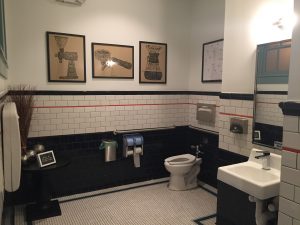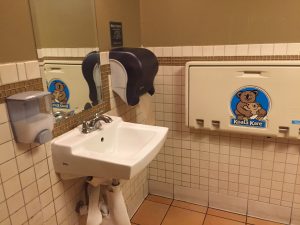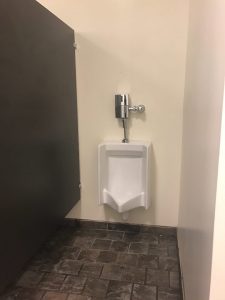
The analyzation of the materials in the different restrooms
Bathroom Materiality
My group analyzed the bathrooms according to their materiality to inquire whether there is a difference amid the gendered bathrooms. Is there a need for gender-specific bathrooms?

Kaldi’s gender neutral restroom with feminine hygiene unit and baby changing station (on the left wall).
When analyzing the bathrooms, we determined the following items to be the most fundamentally gender-specific: the feminine hygiene disposable unit, the urinal, the signs, and the baby changing station. The feminine hygiene unit and baby- changing station, however, are both present in gender neutral bathrooms, which indicates that they are compatable in a non-gender specified bathroom. Such was illustrated in the Kaldi’s bathroom and the gender neutral bathroom in Long Street Means hall at Emory University.

Panera Bread women’s bathroom with a baby-changing station
The baby changing station should ideally be present in both men’s and women’s restrooms, but such is not common. “Why?” one might ask; my group discovered that it is likely due to the admiration for the societal, traditional value that women, mothers, are expected to take care of a child. This ideal was illustrated in Panera Bread, as there was only a baby-changing station in the women’s restroom.

The sign indicating for women residing in Dobbs Hall to pick up their hair
Societal ideals are also illustrated in the women’s restroom in Emory University’s Dobbs Hall, which possesses a sign stating for women to pick up there hair. Consequently, this associates women to having longer hair and possessing this responsibility.

A men’s urinal in Emory University’s Goizueta Business School
The men’s urinal, however, offered a different perspective since it is solely found in a men’s gender specified restroom. Why? It was determined that for men, it is often a cleaner means to use the restroom and a means to conserve water. Although it is not required, it still possesses a frequent appearance in society, which is illustrated in the men’s restroom of Emory University’s Goizueta Business School.
Conclusively, my group determined that the materiality of a bathroom can indicate the societal ideals and the environment of a community.